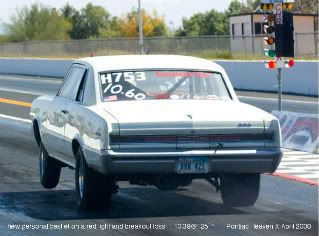| FAQ |
| Members List |
| Social Groups |
| Calendar |
| Search |
| Today's Posts |
|
#21
|
||||
|
||||
|
Jon,
I appreciate the information also; I've changed the jet sizes on my little poop sheet plus made note of your other tips. John |
|
#22
|
||||
|
||||
|
Jon, a long time ago I aquired a box of blister packed jets, mostly 70s I think and some rods and springs.
Is there a part numbering convention that would distinquish the older style from the newer? If so I might have a better idea of what I have. Or would you suggest I just visually compare with what is in some older and newer carbs I have? Also I have a afb I want to use (matched set, later style) that some buthead broke one of the the idle air bleed screws off just at the narrow part of the screw. the needle tip is in the bottom of the hole of course where I cant grab it. Best way to get it out?
__________________
  My Daddy bought me a car but all I got was this old Pontiac. My Daddy bought me a car but all I got was this old Pontiac. 
|
|
#23
|
||||
|
||||
|
BVR421 - Up until about 1968, Carter codefied the prefix to the jets (120), but the rest of the number was just a number (without significance).
After about 1968, Carter codefied the entire jet number as follows: 120-nnn. This coding is ONLY VALID FOR NUMBERS 120-350 AND ABOVE! The 120 specifies main metering jet. Jets in the range 120-350 to 120-420 are standard burnished jets for AFB (and AVS SECONDARY ONLY!!!). Jets from 120-350 to 120-399 are less than 100 thousanths with the last 2 digits representing the size eg. 120-389 is a jet of size 0.089. Jets from 400 to 420 are 0.100 plus the last 2 digits eg. 120-410 is a jet of size 0.110. Jets from 120-421 to 120-480 are used in some of the 1 and 2 barrel carbs sold to Chrysler. THEY WILL NOT WORK IN AFB CARBS. Jets from 120-489 to 120-501 are high-step jets. THESE ARE SPECIAL JETS AND CAN BE USED ONLY IN THE PRIMARY OF THE AVS CARBS WITH THE SPECIAL 3 STEP RODS AND THE SPECIAL PRIMARY CLUSTERS OF THE AVS. THESE CANNOT BE USED IN THE AFB. The same convention applies to size. Jets from 120-489 to 120-499 the last 2 digits represents the size eg 120-489 is a high step jet of size 0.089. 120-501 is a high step jet of size 0.101. Jets with the format 120-nnnn (4 digits) are for the Thermoquad, of which there are 8 different styles. I do not wish to attempt to explain these here. If you need TQ jets, CALL Some of the "blister-pak" jets has a P (Pack) in the number ie 120-P389. Ignore the P and decode as above. There is no codification of the rods other than the 16 for the prefix number. The other number has no significance other than part numbers. Also, there was both a "stamped" number and a "sales" number. Sometimes they are identical, other times they differ. BVR421 - my HONEST belief is that if you plan to use that pair of late AFB's on a Pontiac; it would be better simply to sell them to a Chevy dude than attempt to remove the twisted idle mixture control needle. However, should you not share this opinion, things to try: Some of the later AFB's used steel needles, others were brass. The method used depends on the construction of the needle. If brass: First, heat the entire throttle body in an oven for about 30 minutes at 500 degrees F. Allow to completely cool naturally. Now align the throttle body in an angled milling vise, and using a tiny carbide burr, center a hole in the twisted needle. Now remove the burr and place a SHARP reverse twist drill bit in the mill and start a small hole in the needle. Now remove the SHARP drill bit, and place a DULL reverse twist drill bit in the needle. Try to jam the bit, and if you are lucky, the needle will unscrew with the bit. If steel: Depending on your welding skills, either do this yourself or take it to a professional. My own welding resembles the under side of a desk in first grade And you still have a carburetor unsuitable without modification for a Pontiac Have fun. Jon.
__________________
"Good carburetion is fuelish hot air".  "The most expensive carburetor is the wrong one given to you by your neighbor". If you truly believe that "one size fits all" try walking a mile in your spouse's shoes! Owner of The Carburetor Shop, LLC (of Missouri). Current caretaker of the remains of Stromberg Caburetor, and custodian of the existing Carter and Kingston carburetor drawings. |
|
#24
|
||||
|
||||
|
jon, thanks for useful info and thanks for all the time you spend trying to keep everyone straight on this stuff.
__________________
  My Daddy bought me a car but all I got was this old Pontiac. My Daddy bought me a car but all I got was this old Pontiac. 
|
| Reply |
|
|